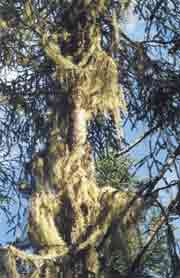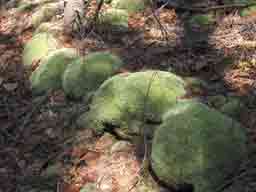
December 2003
 Comparative
study of black spruce stands originating after
harvest or after fire Comparative
study of black spruce stands originating after
harvest or after fire
Because careful
logging around regeneration (also known as CPRS) is now the practice
in Quebec, it is important to acquire knowledge on the growth and
yield of the stands resulting from this cutting approach. This is
what a group of researchers from the Canadian Forest Service and
the Université du Québec à Chicoutimi set out
to do. They described and analyzed from a comparative standpoint
some 15 stands of black spruce, half of them originating from cutting
and half from fires in the first part of the 20th century. They
were particularly interested in the diameter structure of the stands,
as this factor affects stand productivity, but they also compared
the evolution of stand structure and evaluated productivity based
on the height of the regeneration at the time of harvesting.
The researchers found that, even if second-growth
black spruce stands had an uneven-aged structure and a well-defined
hierarchy initially, they evolved in a very similar way to the fire-origin
stands, albeit more slowly. In the end, however, the diameter structure
of cut stands is more asymmetrical than that of virgin stands, with
a larger proportion of small diameter stems.
With respect to stand productivity, the researchers
found that harvest-origin black spruce stands were more productive
than fire-origin ones for two reasons: their basal area was equal
to or greater than that of the virgin stands and the majority of
stems conserved at the time of cutting were over 1 metre tall.
For information:
 Biodiversity:
Preserving lichen and bryophyte communities Biodiversity:
Preserving lichen and bryophyte communities
 Timber
harvesting in the mature and old-growth forests characterizing our
landscapes poses a potential threat to some forest-dwelling plant
species such as bryophytes (mosses and liverworts) and lichens. Timber
harvesting in the mature and old-growth forests characterizing our
landscapes poses a potential threat to some forest-dwelling plant
species such as bryophytes (mosses and liverworts) and lichens.
To protect these plant communities, it is essential
to identify their respective successional stages and the characteristics
of the sites where they grow. Canadian Forest Service researchers,
working in conjunction with colleagues in the Interuniversity Forest
Ecology Research Group (GREFI) at the Université du Québec
à Montreal, undertook a study in which they sampled 22 spruce–moss
stands, aged 80 to over 200 years old, and evaluated the diversity
and abundance of the bryophyte and lichen communities growing on
the forest floor or in the tree canopy.
Upon completing this survey, the researchers made
several recommendations for preserving these plant communities.
One of these involves adopting a combined landscape-level and stand-level
approach to maintain habitat diversity, which is essential for preserving
the diversity of bryophyte and lichen communities. The researchers
noted that certain tree-dwelling lichens are more abundant on older
trees and that these trees could be conserved through partial cuts.
 The
researchers also indicated that clearcut sites are likely to give
rise to paludification (rise in the water table) more quickly than
is the case with fire-disturbed sites. Consequently, if we want
to emulate nature, scarification and controlled burning are techniques
that should be employed in some cases to create environments favourable
for the plant communities concerned. The
researchers also indicated that clearcut sites are likely to give
rise to paludification (rise in the water table) more quickly than
is the case with fire-disturbed sites. Consequently, if we want
to emulate nature, scarification and controlled burning are techniques
that should be employed in some cases to create environments favourable
for the plant communities concerned.
For information:
 Yellow
birch more vulnerable to ice damage than previously
thought Yellow
birch more vulnerable to ice damage than previously
thought
 Did
the major ice storm that hit southwestern Quebec in January 1998
have an impact on timber production in the affected regions? Because
of the lack of research on this topic, a Canadian Forest Service
researcher undertook a study in the Saint-Zacharie forest, in the
Eastern Townships region of Quebec. One of his aims was to endeavour
to evaluate the effect of ice damage on the growth of the main species
in a sugar maple–yellow birch stand. Did
the major ice storm that hit southwestern Quebec in January 1998
have an impact on timber production in the affected regions? Because
of the lack of research on this topic, a Canadian Forest Service
researcher undertook a study in the Saint-Zacharie forest, in the
Eastern Townships region of Quebec. One of his aims was to endeavour
to evaluate the effect of ice damage on the growth of the main species
in a sugar maple–yellow birch stand.
The condition of a stand of this type was assessed
three years after the ice storm by measuring the diameter growth
of the main species and comparing it with the diameter growth trends
that existed prior to this major disturbance. Yellow birch is the
species that suffered the greatest volume losses (32%), followed
by white ash (11%). These volume losses accounted for only about
5% of the total volume of the stand—a decrease that appears
relatively small compared with the losses previously reported in
other studies of young sugar maple–yellow birch stands. Based
on the results obtained, the researcher could not detect significant
ice effects on stem diameter growth, regardless of the damage class
and the species considered.
In the stand studied, the majority of sugar maple
and beech stems suffered no damage or only minor damage, whereas
two thirds of the yellow birch stems sustained moderate to severe
damage. The study seems to show that, in a mature high forest, sugar
maple and hemlock are quite resistant to ice damage, whereas yellow
birch is more vulnerable than some researchers believed.
For information:
 Frost
damage to seedling root systems and effects
on growth Frost
damage to seedling root systems and effects
on growth
 The
risk of frost and damage to seedling root systems is a problem that
all tree nurseries face, particularly for containerized seedlings
that need to be hardened off outdoors. To gain a better understanding
of the effects of frost on seedlings, researchers with the Canadian
Forest Service and the Forest Biology Research Centre at Université
Laval exposed black spruce, jack pine and white spruce seedlings
to fall frosts, stored them in a cold room and then planted them
in spring in two different types of soil, one damp and the other
dry. The researchers also evaluated the extent of root damage in
the seedlings in order to relate this to mortality and growth data. The
risk of frost and damage to seedling root systems is a problem that
all tree nurseries face, particularly for containerized seedlings
that need to be hardened off outdoors. To gain a better understanding
of the effects of frost on seedlings, researchers with the Canadian
Forest Service and the Forest Biology Research Centre at Université
Laval exposed black spruce, jack pine and white spruce seedlings
to fall frosts, stored them in a cold room and then planted them
in spring in two different types of soil, one damp and the other
dry. The researchers also evaluated the extent of root damage in
the seedlings in order to relate this to mortality and growth data.
For black spruce and white spruce, the study results
suggest that 50% or more of the root system has to undergo frost
damage before there is any effect on the mortality rate. In jack
pine, frost damage to 40% of the root system is the threshold beyond
which an effect is seen on mortality.
The researchers also measured stomatal conductance
and photosynthesis and observed that these processes decreased as
the amount of damage increased. They pointed out that the reduction
in growth observed depended to a great extent on the site and the
prevailing environmental conditions, which differed at the two sites.
They pointed out that their observations covered only one growing
season and a fairly small number of seedlings.
For information:
 Does
planting white pines under a canopy have an
effect on weevil attacks? Does
planting white pines under a canopy have an
effect on weevil attacks?
In order to prevent
or reduce the impact of weevil attacks on white pine, it is recommended
that white pine trees be grown under a canopy of larger trees or
companion species during the period in the species’ life cycle
when it is most vulnerable to attack. But what effect does this
approach actually have on weevil feeding, egg laying and emergence?
Some researchers with the Canadian Forest Service and the Interuniversity
Forest Ecology Research Group (GREFI) at the Université du
Québec à Montréalcarried out a study to address
these questions. They identified the relationships that existed
between the forest canopy (by using basal area as an indicator)
and weevil behaviour in an experimental plot containing 63 white
pine about 12 years old growing under the protective cover of pioneer
species in the Outaouais region.
It appears that some parameters associated with weevil
behaviour, such as the intensity of feeding and egg laying, are
correlated with the forest canopy, whereas others are not, including
the number of pupal chambers, emergence holes and various indicators
of survival. The results of this study show that growing white pines
under a canopy can be a good strategy for limiting weevil populations,
particularly as this allows natural enemies to have more of a controlling
effect on the weevils. The small number of adults that emerge serves
to check the infestation, allowing mechanical control methods to
be used to good effect.
Growing white pine under protective cover is
not easy to accomplish, however, and this approach appears to have
an effect on stem diameter growth, among other aspects. However,
the researchers believe this strategy could be very useful, given
the potential control offered by natural enemies of the white pine
weevil.
For information:
|